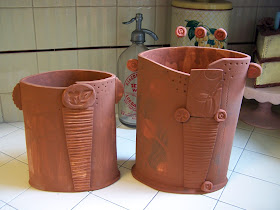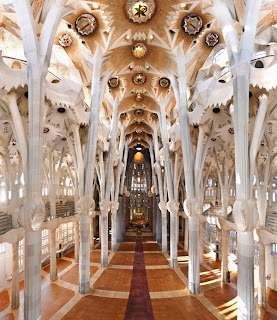"There is a shroud of mystery surrounding Gaudi. In all probability, the first mist preventing us from gaining access to his work is the intrinsic mysteriousness of all genius and, at the end of the day, of all human spirit. The situation is complicated by the well-known fact that Gaudi wished to create an aura of silence around his persona." Juan-Eduardo Cirlot
It doesn't get much better than Gaudi. What kind of a person decides to build an enormous cathedral in the 20th Century? A deeply spiritual man, with a mastery of all applied arts, and a devotion to nature.
Gaudi was incredibly spiritual. His work is replete with religious symbols. Even his non-religious projects. His work depicts an intensity, and a reverence for nature. It is easy to see his love of this world, by his dedication in reproducing it, after his own manner. It is the work of someone who intimately understands the divinity of the creative process.
Gaudi understood the applied arts. He seemed to know how far a craftsman could go, and then he asked the craftsman to push a bit further. Ceramic, tile work, woodworking, masonry, ironwork, and glassblowing, were known quantities to him. The ironwork on his buildings is absolutely breathtaking. It can appear to be ribbon, kelp, palmetto, dragon spines, all with the appropriate texture and finish. The woodwork in Casa Batllo shows impossible curves, openings, and budding doors. All pieces are hand joined and fitted. It is as though all the craftsmen in Catalonia were called upon to prove their skill.


Gaudi was entranced by nature. His study of natural forms showed his interest in math, and in all of the scientific disciplines. The nave of Sagrada Familia is a mathematical enchanted forest. It is said that Gaudi planned the stained glass windows in the nave, to shade and shimmer like sunlight in a forest. Although it is based on nature, Sagrada Familia is unlike any other place on earth. The parabolic arches that Gaudi loved to use, make the vented laundry loft in Casa Batllo, into a living, breathing biological body.
Antoni Gaudi lived alone. He spent most of his life, devoted to his profession. He died after being hit by a tram, while on his daily walk. It is said that the streets of Barcelona were full of mourners as his coffin made it's way to be buried in the crypt at Sagrada Familia. The cathedral above him, is still a work in progress.




















